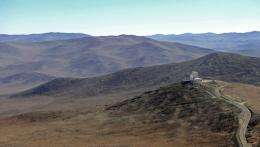Astronomers back Chile to host huge telescope

For astronomers, it appears that not only does size really matter but so does an eye-opening location.
That is why an international group of four professional star gazers have banded together to back Chile's Atacama desert as home to the world's biggest telescope, to be built in 2018 based on its geographical advantages.
The high-altitude Armazones mountain in the desert in northern Chilean desert is the perfect place for the European Extremely Large Telescope (ELT) to be set up, because of skies that are cloud-free 360 nights a year, they say.
The four astronomers -- two Chileans, an Italian and a German -- were in the desert this week to evaluate its suitability compared to the main other contender: the Spanish isle of La Palma in the Canary Islands off western Africa.
"We are talking about the biggest telescope in the world, the biggest for a long time to come. That means we have to choose the best spot. Chile has a superb location. It's the best in the world, there's no doubt," the Italian, Massimo Tarenghi, told AFP.
Tarenghi represents the European Southern Observatory, an intergovernmental astronomical research agency that already has three facilities operating in the Atacama desert, including the Very Large Telescope array in the town of Paranal which is currently considered Europe's foremost observatory.
The ELT is intended to dwarf the VLT.
The project calls for the construction of a huge telescope with a mirror 42 meters (138 feet) in diameter -- nearly as big as an Olympic-sized swimming pool. It will permit optical and near-infrared peering into the heavens.
Work on the ELT is to begin in December 2011 and cost 120 million dollars (90 million euros).
When complete, the device will be "the world's biggest eye on the sky," according to the ESO, which hopes it will "address many of the most pressing unsolved questions in astronomy."
The ELT could be as revolutionary in the field of astronomy as Galileo's telescope 400 years ago that determined that the Sun, and not the Earth, was the center of our universe, according to the European agency based in Munich, Germany.
The German astronomer in Chile, Wolfgang Gieren, waxed happily about the possibilities of the future telescope.
"In no more than 15 years we could have the first good-resolution spectra of planets outside our universe that are the same size of Earth and see if we can detect signs of life," he said.
One of the Chilean astronomers, Mario Harmuy, said the Armazones, with an altitude of 3,500 meters, provided an ideal location.
"Several things come together here. The cold Humboldt Current, which passes by Chile's coast, means that there is a high pressure center in the Pacific that deviates high clouds and prevents cover over this part of the continent," he said.
"To the east, the high Andes mountains prevent humidity from moving in from the Atlantic with clouds. The higher you are, the less humidity there is, and thus the light from the stars go through less atmosphere and is distorted less when it hits the telescope."
To boot, the Chilean location is free of the storms that hit the Canary Islands and the Sahara, he said.
Tarneghi added that the ESO's existing Paranal observatory nearby also meant that much of the ground infrastructure was already in place.
Chile's government was equally enthusiastic about hosting the Extremely Large Telescope.
Gabriel Rodriguez, in charge of the foreign ministry's science and technology division, said Chile was ready to cede the 600 hectares (1,500 acres) needed for the project.
The government is to submit its offer to the ESO next Monday, with a decision expected early March.
The Italian astronomer cautioned that despite Chile's obvious advantages, the tender had to be weighed carefully for all its aspects.
"Neither us nor the ESO know what the final decision will be. We need to receive the Chilean and Spanish proposals and evaluate factors of operation, work and production costs," Tarenghi said.
The other Chilean astronomer, Maria Teresa Ruiz, remained fired up at the potential of the new instrument.
The "surface area of this telescope is bigger than all the others in Chile combined, which will allow us to explore things in the universe that we can't even imagine today," she said.
(c) 2010 AFP


















